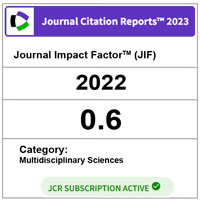Physical properties of bitumen containing diatomite and waste engine oil
DOI:
https://doi.org/10.11113/mjfas.v15n4.1230Keywords:
Diatomite, WEO, bitumen, penetration, physicalAbstract
The addition of modifier, either to replace bitumen or as an additive, could potentially improve the performance of conventional bitumen used in road construction. This study characterizes the physical properties of bitumen 80/100 penetration grade modified with diatomite powder and waste engine oil (WEO). Different percentages of WEO i.e. 1%, 2%, and 3%, were added with 1% diatomite to the bitumen. The conventional and modified bitumen samples were tested for penetration, softening point, viscosity, and loss on heating. Results showed that the increase of WEO content, particularly at 3% in the modified bitumen, has softened the bitumen with lower softening point and higher loss on heating than the unmodified sample. In contrast, the diatomite powder has shown potential in reinforcing the bitumen structure at high temperature based on higher viscosity obtained at 165°C compared to conventional bitumen.
References
Abdullah, N. A. M., Hassan, N. A., Shukry, N. A. M., Mahmud, M. Z. H., Putrajaya, R., Hainin, M. R., Yusoff, N. I. M. 2016. Evaluating potential of diatomite as anti-clogging agent for porous asphalt mixture. Jurnal Teknologi (Sciences & Engineering), 78(7-2), 105-111.
ASTM D6/D6M-95(2011)e1, Standard test method for loss on heating of oil and asphaltic compounds, ASTM International, West Conshohocken.
ASTM D5-06e1, Standard test method for penetration of bituminous material, ASTM International, West Conshohocken.
ASTM D36/D36M-14e1, Standard test method for softening point of bitumen (ring and ball apparatus), ASTM International, West Conshohocken.
ASTM D2170/D2170M-10, Standard test method for kinematic viscosity of asphalts (bitumens), ASTM International, West Conshohocken.
Cheng, Y., Tao, J., Jiao, Y., Guo, Q., Li, C. 2015. Influence of diatomite and mineral powder on thermal oxidative aging properties of asphalt. Advanced in Materials Science and Engineering, 2015, 1-10.
Cong, P., Chen, S., Chen, H. 2012. Effects of diatomite on the properties of asphalt binder. Construction and Building Materials, 30, 495–499.
Degirmenci, N., Yilmaz, A. 2009. Use of diatomite as partial replacement for portland cement in cement mortars. Construction and Building Materials, 23(1), 284–288.
Dominguez-Rosado, E., Pichtel, J. 2003. Chemical characterization of fresh, used and weathered motor oil via GC/MS, NMR and FTIR techniques. Proceedings of the Indiana Academy of Science, 112(2), 109-116.
Ehinola, O. A., Falode, O. A., Jonathan, G., 2012. Softening point and penetration index of bitumen from parts of Southwestern Nigeria. Nafta, 63(9-10), 319-323.
Guo, Q., Li, L., Cheng, Y., Jiao, Y., Xu, C. 2015. Laboratory evaluation on performance of diatomite and glass fibre compound modified asphalt
mixture. Materials and Design, 66(2015), 51–59.
Ibrahim, S. S. 2012. Diatomite Ores: Origin, characterization and applications. Journal of International Environmental Application & Science, 7(1), 191–199.
Jia, X., Huang, B., Bowers, B., Zhao, S. 2014. Infrared spectra and rheological properties of asphalt cement containing waste engine oil residues. Construction and Building Materials, 50 (1), 683-691.
Jiang, L., Liu, Q. 2014. Application of diatomite modified asphalt. Applied Mechanics and Materials, 477-478, 959-963.
Kamaruddin, N. H. M., Hainin, M. R., Hassan, N. A., Abdullah, M. E. 2014. Rutting evaluation of aged binder containing waste engine oil. Advanced Materials Research, 911, 405-409.
Kolo, S. S., Jimoh, Y. A., Adeleke, O. O., Adama, A. Y., Akinmade, O. D. 2016. Response of cold mix asphalt produced with straight run bitumen blended with polyethylene to static loading. Jurnal Teknologi, 79(1), 131-136.
Newman, P., Hargroves, C., Kumar, A., Whistler, L., Farr, A., Wilson, K., Beauson, J., Matan, A., Surawski, L. 2012. Reducing the environmental impact of road construction. Sustainable Built Environment National Research Centre, Brisbane, Queensland.
Shukry, N. A. M., Hassan, N. A., Hainin, M. R., Abdullah, M. E., Abdullah, N. A. M., Mahmud, M. Z. H., Putrajaya, R., Mashros, N. 2016. Experimental evaluation of anti-stripping additives on porous asphalt mixtures. Jurnal Teknologi (Sciences & Engineering), 78(7-2), 113-119.
Villanueva, A., Ho, S., Zanzotto, L. 2008. Asphalt modification with used lubricating oil. Can. Journal of Civil Engineering, 35(2), 148–157.
Yi-qiu, T., Lei, Z., Xing-you, Z. 2012. Investigation of low-temperature properties of diatomite-modified asphalt mixtures. Construction and Building Materials, 36, 787-795.
Zhu, D. P., Zhang J. C., Chen J. B., Yuan, K., Cheng, C. 2013. Experiment on road performance of diatomite modified asphalt mixture in permafrost region. China Journal of Highway and Transportation, 26, 23-28.







